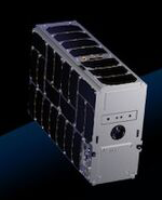| Satellite name | Avion-Kaluga 650 |
|---|---|
| Type | CubeSat |
| Units or mass | 6U |
| Status | Operational (Assumed to be operational because the object ID is known) |
| Launched | 2023-06-27 |
| NORAD ID | 57195 |
| Deployer | 12U Deployer [Aerospace Capital] |
| Launcher | Sojuz |
| Organization | Lomonosov Moscow State University |
| Institution | University |
| Entity type | Academic / Education |
| Nation | Russia |
| Manufacturer | AIVT by ? |
| Operator | ? |
| Partners | Skobeltsin NIIYaF, NILAKT DOSAAF Kaluga |
| Oneliner |
Study the temporal and spectral characteristics of electrons and gamma radiation. |
| Description |
AZN-V aircraft control system; Fast electron flow, gamma-ray bursts monitoring with DEKOR-3 detector. The subject of the study will be cosmic gamma-ray bursts, solar flares, electron precipitation, and the relationship of particle fluxes with solar activity. The complex includes three scintillation spectrometers, whose characteristics complement each other. The DeCoR-1 node, similar to the DeCoR devices operating on the VDNH-80, Norby, and several others cubesats, is primarily designed to study variations of near-Earth electron fluxes. Its detection element is a combination of a 3 mm thick plastic scintillator and a 10 mm thick CsI(Tl) crystal, viewed by two PMTs. It has an effective area of 18 cm2 and an energy release range of 50 keV to 2 MeV. The DeCoR-3 node is used to extend the range of detected gamma radiation to the high-energy region up to 10 MeV. Its main goal is to measure the gamma-ray spectra of solar flares and cosmic gamma-ray bursts. The detecting element of this node is a 30x30x30 mm3 Ce:GAGG scintillation crystal. The DeCoR-2 device, optimized for the detection and study of cosmic gamma-ray bursts of various nature, has an effective area increased to 65 cm2, which is necessary both to improve the sensitivity and to increase the time resolution, which is determined primarily by the statistics of detected gamma-quanta. A composite scintillation detector consisting of a 3 mm plastic scintillator and a 9 mm CsI (Tl), viewed by a silicon photomultiplier assembly (SiPM), allows for separate detection of gamma radiation and electrons in the energy release range from 20 keV to 1 MeV, which is important when conducting an experiment in polar orbit. |
| Sources | [1] [2] [3] [4] |
| Photo sources | [1] |
| On the same launch |
|
Last modified: 2023-12-15

